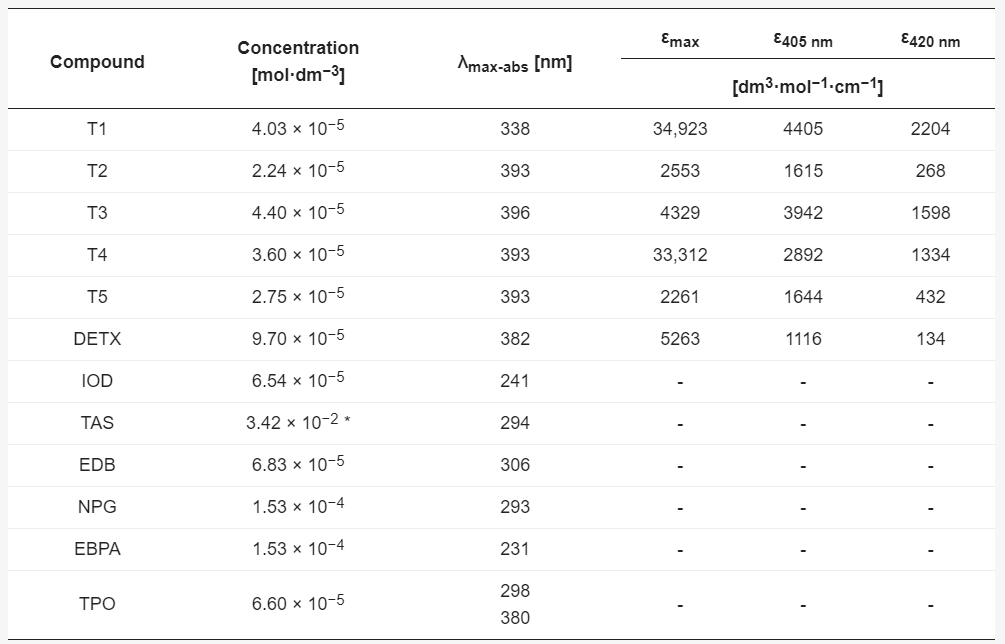Visible light 3D printing is a new frontier for the world of vat photopolymerization, with only a small number of commercial options available for the technology. This includes Photocentric, out of the UK, and T3D in Taiwan. The use of resins that can be cured by visible light means there is no need to rely on ultra violet light and digital projectors, but instead, less expensive options such as LCD screens can be used. Not only can the technology speed up the printing process, but it may be more sustainable and less energy-intensive, as well.
Because the process is comparatively new, researchers are actively working to develop new materials for the process. In the recently published “Thioxanthone Derivatives as a New Class of Organic Photocatalysts for Photopolymerisation Processes and the 3D Printing of Photocurable Resins under Visible Light,” Polish researchers explore the 3D printing of photoinitiators derived from widely used onium salts. These salts are typically more easily used in polymerization processes associated with UV light. To broaden their application to visible light photopolymerization, the team explored the combination of onium salts with a compound called thioxanthone.
In this study, the researchers explore five new thioxanthone-based compounds:
“… thioxanthone derivatives with 4-(diphenylamine)phenyl substituents and carbazole-based substituents in position 7 of 2,4-diethylthioxanthen-9-one. Thus, compounds consisting of two chromophoric parts were developed. Carbazole derivatives are themselves well-known additives in photopolymerization processes, e.g., N-vinylcarbazole (NVK) and 9H-carbazole-9-ethanol (CARET),” stated the researchers.
They also used carbazole derivatives for initiating 3D printing, due to their absorption properties. The creation of new systems that could initiate both cationic and radical photopolymerization processes was a critical point of interest for the authors.

(a) Absorption properties of 2,4-diethyl-thioxanthen-9-one derivatives in acetonitrile. (b) Absorption properties of onium salts and other additives used as components for photoinitiating systems: IOD—bis(4-t-butylphenyl)-iodonium hexafluorophosphate, TAS—triarylsulfonium hexafluorophosphate salts, EDB—ethyl 4-(dimethylamino)benzoate, NPG—N-phenylglycine, EBPA—ethyl α-bromophenylacetate, TPO—diphenyl(2,4,6-trimethylbenzoyl)phosphine oxide.

Light absorption data of 2,4-diethyl-thioxanthen-9-one derivatives in acetonitrile: maximum absorption wavelengths (λmax-abs), molar extinction coefficients (ε) at λmax and at the maximum of the emission wavelengths of the LEDs 405 nm and 420 nm.
The researchers began with studying light absorption properties of 2,4-diethyl-thioxanthen-9-one derivatives, along with the interesting absorption properties of additives like onium salts. Next, they studied the performance of derivatives such as 2,4-diethyl-thioxanthen-9-one for acting as photosensitizers. This allowed the researchers to integrate the use of light-emitting diodes (LEDs) for light sources in photopolymerization, while texting other reference systems in the same experimental environment.

Photopolymerisation profiles of UVACURE®1500 (epoxy function conversion vs. irradiation time under air in the presence of different photoinitiating systems based on IOD (1% w/w) and 2,4-diethyl-thioxanthen-9-one derivatives (0.2% w/w) ) upon exposure to (a) the visible LED@405 nm, (b) the visible LED@420 nm. The irradiation starts at t = 10 s.
Onium salt is central to much of this process, depending on electrons, and reaching photosensitization via the electron transfer process—with one electron donor being transferred from the photosensitizer to the electron acceptor. The photoredox rection occurs with the photosensitizer being oxidized, and the onium salt decreased.

The pattern obtained after the 3D printing experiment based on formulation with T1 (0.07% w/w) and TMPTA.
3D printing experiments were also performed on laser diode irradiation, using a variety of photoinitiating systems. These were based on the following: 2,4-diethyl-7-[4-(N-phenylanilino)phenyl]thioxanthen-9-one (T1) in TMPTA and in a TMPTA/UVACURE®1500 blend. The researchers noted that because of the “high photosensitivity” of the thioxanthone derivative T1 formulations, photopolymerization was effective—and efficient.

The pattern obtained after the 3D printing experiment based on formulation with T1 (0.07% wt.)/IOD (0.33% wt.) and TMPTA/UVACURE®1500 (1:1).
The researchers used a NEJE DK-8-KZ 1000 mW Laser Engraver Printer for experimenting with the 3D objects, observing them with an optical stereo microscope, and a multifunctional digital microscope. An M365L2 UV-LED was used as the light source.
Information on patents follows:
Patent application P.434493 with priority date 29 June 2020, authors: Joanna Ortyl and Emilia Hola, title: “New derivatives of thioxanthen-9-one, methods of their preparation, new photoinitiating systems for the photoinitiated processes of cationic, radical, thiol-ene and hybrid polymerization, and the use of new derivatives of thioxanthen-9-one and 2,4-diethyl-thioxanthen-9-one.”
(Source / Images: “Thioxanthone Derivatives as a New Class of Organic Photocatalysts for Photopolymerisation Processes and the 3D Printing of Photocurable Resins under Visible Light”)
Subscribe to Our Email Newsletter
Stay up-to-date on all the latest news from the 3D printing industry and receive information and offers from third party vendors.
Print Services
Upload your 3D Models and get them printed quickly and efficiently.
You May Also Like
The Dental Additive Manufacturing Market Could Nearly Double by 2033, According to AM Research
According to an AM Research report from 2024, the medical device industry, specifically in dentistry, prosthetics, and audiology, is expected to see significant growth as these segments continue to benefit from...
Heating Up: 3D Systems’ Scott Green Discusses 3D Printing’s Potential in the Data Center Industry
The relentless rise of NVIDIA, the steadily increasing pledges of major private and public investments in national infrastructure projects around the world, and the general cultural obsession with AI have...
AM Research Webinar Explores Continuum’s Sustainable Metal Additive Manufacturing Powders
Metal additive manufacturing (AM) powder supplier Continuum Powders is working to develop solutions that empower industries to reduce waste and optimize their resources. An independent life cycle assessment (LCA) of...
3D Printed Footwear Startup Koobz Lands $7.2M in Seed Round
California-based Koobz is focused on reshoring the U.S. footwear supply chain with advanced manufacturing processes, including 3D printing. The startup just announced that it has added $6 million to its...


































